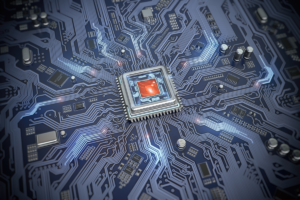Back in the 1960s, the rock-and-roll group The Tremeloes recorded a song entitled, “Silence is Golden.” The chorus lyrics to that song were:
Silence is golden
But my eyes still see
Silence is golden, golden
But my eyes still see
As I explain below, those lyrics could well be the chorus to a new song entitled, “Needed Breakthrough in Quantum Computing.”
For those unfamiliar with quantum computing, it’s computing based on weird particle properties found only at the quantum level of physics. To say concepts involved in quantum computing are mind-bending actually understates the weirdness involved. In simple terms, a quantum computer is a computer that takes advantage of the fact that, at the quantum level, a quantum bit (aka qubit) can simultaneously be both a 0 and a 1 — this phenomenon is called superposition. The weirdness continues with a phenomenon called entanglement. Quantum entanglement involves a pair of quantum particles linked together in a such a way that when one particle is altered its twin is instantaneously altered in exactly the same way regardless of how far apart the entangled particles may be. Professor Albert Einstein famously called entanglement “spooky action at a distance.” Because a qubit can simultaneously be both a 0 and a 1, quantum machines compute differently than traditional machines. James Norman explains, “Quantum computers can be game changers because they can solve important problems no existing computer can. While conventional computing scales linearly, QC scales exponentially when adding new bits. Exponential scaling always wins, and it’s never close.”[1]
Why silence is golden in quantum computers
According to the Science Blog, “Superconducting qubit systems are considered one of the leading contenders in the race to build scalable, high-performing quantum computers. But, like other qubit platforms, they are highly sensitive to their environment and can be affected by both external noise and internal noise. External noise in quantum computing systems could come from control electronics or stray magnetic fields. Internal noise could come from other uncontrolled quantum systems such as material impurities. The ability to reduce noise is a major focus in the development of quantum computers.”[2] In fact, qubits are notoriously fragile.
Most attempts to create qubits require researchers to work at temperatures near absolute zero and to build elaborate shields to protect qubits from interference by outside disrupters. Rob Matheson, from MIT explains, “A qubit’s quantum ‘coherence’ — meaning its ability to maintain the superposition state — can fall apart due to noise coming from environment around the qubit. Noise can arise from control electronics, heat, or impurities in the qubit material itself, and can also cause serious computing errors that may be difficult to correct.”[3] He goes on to report, “MIT and Dartmouth College researchers have demonstrated, for the first time, a tool that detects new characteristics of environmental ‘noise’ that can destroy the fragile quantum state of qubits, the fundamental components of quantum computers. The advance may provide insights into microscopic noise mechanisms to help engineer new ways of protecting qubits.”
The Science Blog reports, “The [Dartmouth/MIT] experiment was based on earlier theoretical research conducted at Dartmouth and published in Physical Review Letters in 2016.”[3] Lorenza Viola, a professor of physics at Dartmouth who led the 2016 study as well as the theory component of the present work, stated, “This is the first concrete step toward trying to characterize more complicated types of noise processes than commonly assumed in the quantum domain. As qubit coherence properties are being constantly improved, it is important to detect non-Gaussian noise in order to build the most precise quantum systems possible.” Leigh Norris, a postdoctoral associate at Dartmouth that co-authored the study, adds, “The big barrier preventing us from having large-scale quantum computers now is this noise issue. This research moves us toward understanding the noise, which is a step toward cancelling it, and hopefully having a reliable quantum computer one day.”
Other potential breakthroughs
Researchers from RIKEN, Japan’s largest comprehensive research institution, “have crafted a new architecture for quantum computing. By constructing a hybrid device made from two different types of qubit — the fundamental computing element of quantum computers — they have created a device that can be quickly initialized and read out, and that simultaneously maintains high control fidelity. … According to Akito Noiri of CEMS, the lead author of the study, ‘With this study we have demonstrated that different types of quantum dots can be combined on a single device to overcome their respective limitations. This offers important insights that can contribute to the scalability of quantum computers.'”[4]
Tristan Greene (@mrgreene1977) reports “qutrits” rather than “qubits” might be the future of quantum computing. Greene explains, “What’s a qutrit? It’s a lot like a qubit, an entangled pair of particles used to carry information in a quantum computing system. Qubits are analogous to bits, the binary units of information used by classical computers like the one you’re reading this on. Where bits can be represented by the numbers zero and one, qubits can be zero, one, or both at the same time. Trits, used in classical ternary systems, add a two into the mix. And qutrits are the quantum version of trits, capable of carrying more information than their qubit counterparts. They’re also not as noisy as qubits. But they’re difficult to create and, until now, their use in quantum systems has only been theoretical.”[5] He qualifies his remarks with “until now” phrase, because, “Two independent research teams recently published studies indicating they’ve successfully teleported a qutrit — possibly within days of each other. Now, both await the scientific process of peer review to see which will ultimately get credit for being the first humans to do so.” Greene concludes, “Rivalries aside, both teams deserve credit for demonstrating an amazing, novel scientific feat with potentially revolutionary implications for quantum computing. One of the biggest problems facing physicists focused on building quantum computer technology is noise — errors that occur due to the fragile nature of conducting measurements at the quantum level. Qutrits should have an advantage of qubits that could allow for the transmission of greater amounts of information with less overhead and fewer errors.”
One final potential breakthrough worth mentioning is, “A team of physicists has uncovered a new state of matter — a breakthrough that offers promise for increasing storage capabilities in electronic devices and enhancing quantum computing.”[6] Javad Shabani (@JavadShabani19), an assistant professor of physics at New York University, stated, “Our research has succeeded in revealing experimental evidence for a new state of matter —topological superconductivity. This new topological state can be manipulated in ways that could both speed calculation in quantum computing and boost storage. … The new discovery of topological superconductivity in a two-dimensional platform paves the way for building scalable topological qubits to not only store quantum information, but also to manipulate the quantum states that are free of error.”
Although predictions about when a scalable universal quantum computer might actually be created range from soon to not-so-soon, each new development inches us closer to that day.
Footnotes
[1] James Norman, “Quantum Computing Will Revolutionize Data Analysis. Maybe Soon,” Seeking Alpha, 14 March 2018.
[2] Staff, “Dartmouth Research Advances Noise Cancelling For Quantum Computers,” Science Blog, 16 September 2019.
[3] Rob Matheson, “Quantum Computing Breakthrough: New Detection Tool Uncovers ‘Noise’ That Can Kill Qubits,” SciTechDaily, 16 September 2019.
[4] RIKEN, “Hybrid qubits solve key hurdle to quantum computing,” Science Daily, 28 December 2018.
[5] Tristan Greene, “Forget qubits: Quantum physicists successfully teleported ‘qutrits’ in breakthrough experiments,” The Next Web, 8 August 2019.
[6] James Devitt, “Scientists Discover New State of Matter,” New York University press release, 14 August 2019.





